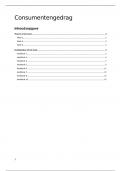Financial Modelling and Analytics
By Thomas Konings
Contents: summary covers theory from lectures and videos as concise as possible. Select
theoretical take-aways from workshops are also included.
Suggested studying method: use summary to practice exams/exercises and redo all workshops.
Contents
Week 1: Hedge Funds ............................................................................................................................. 2
Week 2: Performance Evaluation ........................................................................................................... 3
Week 3: Black-Litterman Model ............................................................................................................. 4
Week 4: Option Pricing Models .............................................................................................................. 6
Week 5: Black-Scholes Model ................................................................................................................. 8
Week 6: Introduction to Financial Risk Management .......................................................................... 12
This summary is part of the Complete & Concise series
stay tuned for summaries of electives
(PE, Value Creation, Distress)
Enjoying the summary? Reviews on Stuvia make my day!
© Thomas Konings – 2020 All rights reserved. Reproduction and distribution are prohibited.
Sold through Stuvia 1
, Week 1: Hedge Funds
Hedge fund: largely exempt from SEC regulation, pursue more speculative investment policies
Idea: wealthier investors need less protection Broad term, these funds follow very different
strategies and risk profiles, and are focused on absolute returns (no benchmark).
Hedge fund vs. (mutual fund): private investment vehicle (SEC registered), allowed to use leverage
(limited), short selling (no short selling) and derivatives (no derivatives), large (small) minimum
investment, low liquidity (daily redemption), flexible (limited) strategies, performance (salary) pay
for managers, managers invest only capital (no capital), absolute return (beat the benchmark)
Full spectrum investing: theory that hedge funds are on one end and index fund on the other, with
many untapped investment opportunities in between.
Hedge fund fees and performance: management fee plus incentive/performance fee. Usually:
2% AUM (Assets Under Management) + 20% of gains (2/20 scheme) + hurdle rate (risk free)
➔ Incentives can then be modeled as call option, but management is incentivized to take risk to
meet hurdle rate (only partially solves agency problem)
High water mark: if loss, then incentive fee only paid when fund makes up for these losses.
Fund of funds: little diversification, HFs follow similar strategies, and add fees on top of underlying
Example why bad: if you invest in a single HF and it returns -5% you pay zero incentive fee, but for a
fund of funds there might be some underlying fund turning a profit, then you still have the fee
Recently: HF returns ↓, due to HF saturation (less arbitrage opportunities), and poor performance
because they chase alpha since 2009. Historically high attrition rate, but stable # firms (mature).
HF Strategies: (1) Directional bets [S&P, interest rates]: fundamental, not market neutral
(2) Non-directional [arbitrage, no free lunches]: exploit temporary misalignment, quantitative
approach, pairs trading (buy one short the other) → relative value / convergence trades
➔ Often using future contracts (known convergence time horizon)
All strategies (there are many more) have different correlations, also during recessions.
HF alpha and beta: why pay fee for beta exposure if you can get it through index fund or ETF?
→ We only pay for alpha (true skill/added value). Investor can short market index to remove market
risk. So: want to know betas w.r.t. passive strategies, then determine alpha from that. But
multifactor models are imperfect especially with non-linear (derivative) returns of HFs.
Portable alpha: earns beta in one asset and alpha in another, implemented using future contracts.
Goal: separate asset allocation (beta) from security selection (alpha). Steps: (1) invest where you
have skill and find alpha (specific market) (2) hedge systematic risk (beta), isolate alpha (see CAPM)
➔ Perfect hedge: ensures that return you earn is risk free + alpha (3) Establish exposure to desired
asset class by using index futures or ETF.
Why/how did HFs do so well? HFs beat passive funds, MFs did not, why?
Reasons: skill, investment flexibility (less regulation), fraud (insider trading), data issues (smoothing,
backfilling, survivorship), risk (liquidity, tail, correlation) [not in standard risk models],
methodological issues (skewness, non-linearities) ➔Measuring true performance is complicated
Note: skill at least somewhat likely, due to higher fee and higher incentive
Survivorship bias: set of funds in sample still exist today (the ones that stopped weren't performing)
Backfill bias: you add a fund to the index that exists today, and incorporate its history, implicit
survivorship bias.
© Thomas Konings – 2020 All rights reserved. Reproduction and distribution are prohibited.
Sold through Stuvia 2











